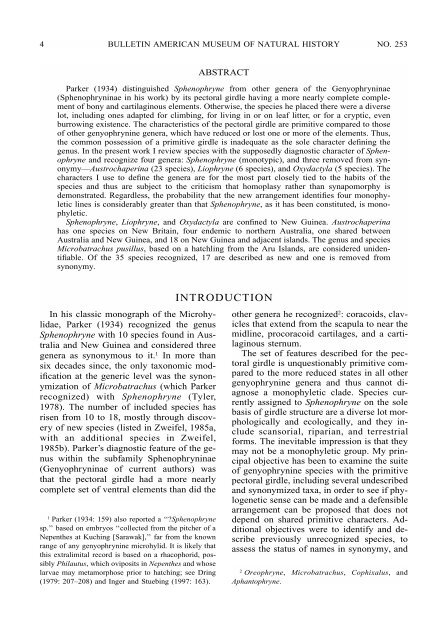SPHENOPHRYNE - American Museum of Natural History
SPHENOPHRYNE - American Museum of Natural History
SPHENOPHRYNE - American Museum of Natural History
You also want an ePaper? Increase the reach of your titles
YUMPU automatically turns print PDFs into web optimized ePapers that Google loves.
4 BULLETIN AMERICAN MUSEUM OF NATURAL HISTORY NO. 253<br />
ABSTRACT<br />
Parker (1934) distinguished Sphenophryne from other genera <strong>of</strong> the Genyophryninae<br />
(Sphenophryninae in his work) by its pectoral girdle having a more nearly complete complement<br />
<strong>of</strong> bony and cartilaginous elements. Otherwise, the species he placed there were a diverse<br />
lot, including ones adapted for climbing, for living in or on leaf litter, or for a cryptic, even<br />
burrowing existence. The characteristics <strong>of</strong> the pectoral girdle are primitive compared to those<br />
<strong>of</strong> other genyophrynine genera, which have reduced or lost one or more <strong>of</strong> the elements. Thus,<br />
the common possession <strong>of</strong> a primitive girdle is inadequate as the sole character defining the<br />
genus. In the present work I review species with the supposedly diagnostic character <strong>of</strong> Sphenophryne<br />
and recognize four genera: Sphenophryne (monotypic), and three removed from synonymy—Austrochaperina<br />
(23 species), Liophryne (6 species), and Oxydactyla (5 species). The<br />
characters I use to define the genera are for the most part closely tied to the habits <strong>of</strong> the<br />
species and thus are subject to the criticism that homoplasy rather than synapomorphy is<br />
demonstrated. Regardless, the probability that the new arrangement identifies four monophyletic<br />
lines is considerably greater than that Sphenophryne, as it has been constituted, is monophyletic.<br />
Sphenophryne, Liophryne, and Oxydactyla are confined to New Guinea. Austrochaperina<br />
has one species on New Britain, four endemic to northern Australia, one shared between<br />
Australia and New Guinea, and 18 on New Guinea and adjacent islands. The genus and species<br />
Microbatrachus pusillus, based on a hatchling from the Aru Islands, are considered unidentifiable.<br />
Of the 35 species recognized, 17 are described as new and one is removed from<br />
synonymy.<br />
In his classic monograph <strong>of</strong> the Microhylidae,<br />
Parker (1934) recognized the genus<br />
Sphenophryne with 10 species found in Australia<br />
and New Guinea and considered three<br />
genera as synonymous to it. 1 In more than<br />
six decades since, the only taxonomic modification<br />
at the generic level was the synonymization<br />
<strong>of</strong> Microbatrachus (which Parker<br />
recognized) with Sphenophryne (Tyler,<br />
1978). The number <strong>of</strong> included species has<br />
risen from 10 to 18, mostly through discovery<br />
<strong>of</strong> new species (listed in Zweifel, 1985a,<br />
with an additional species in Zweifel,<br />
1985b). Parker’s diagnostic feature <strong>of</strong> the genus<br />
within the subfamily Sphenophryninae<br />
(Genyophryninae <strong>of</strong> current authors) was<br />
that the pectoral girdle had a more nearly<br />
complete set <strong>of</strong> ventral elements than did the<br />
1 Parker (1934: 159) also reported a ‘‘?Sphenophryne<br />
sp.’’ based on embryos ‘‘collected from the pitcher <strong>of</strong> a<br />
Nepenthes at Kuching [Sarawak],’’ far from the known<br />
range <strong>of</strong> any genyophrynine microhylid. It is likely that<br />
this extralimital record is based on a rhacophorid, possibly<br />
Philautus, which oviposits in Nepenthes and whose<br />
larvae may metamorphose prior to hatching; see Dring<br />
(1979: 207–208) and Inger and Stuebing (1997: 163).<br />
INTRODUCTION<br />
other genera he recognized 2 : coracoids, clavicles<br />
that extend from the scapula to near the<br />
midline, procoracoid cartilages, and a cartilaginous<br />
sternum.<br />
The set <strong>of</strong> features described for the pectoral<br />
girdle is unquestionably primitive compared<br />
to the more reduced states in all other<br />
genyophrynine genera and thus cannot diagnose<br />
a monophyletic clade. Species currently<br />
assigned to Sphenophryne on the sole<br />
basis <strong>of</strong> girdle structure are a diverse lot morphologically<br />
and ecologically, and they include<br />
scansorial, riparian, and terrestrial<br />
forms. The inevitable impression is that they<br />
may not be a monophyletic group. My principal<br />
objective has been to examine the suite<br />
<strong>of</strong> genyophrynine species with the primitive<br />
pectoral girdle, including several undescribed<br />
and synonymized taxa, in order to see if phylogenetic<br />
sense can be made and a defensible<br />
arrangement can be proposed that does not<br />
depend on shared primitive characters. Additional<br />
objectives were to identify and describe<br />
previously unrecognized species, to<br />
assess the status <strong>of</strong> names in synonymy, and<br />
2 Oreophryne,<br />
Aphantophryne.<br />
Microbatrachus, Cophixalus, and
















